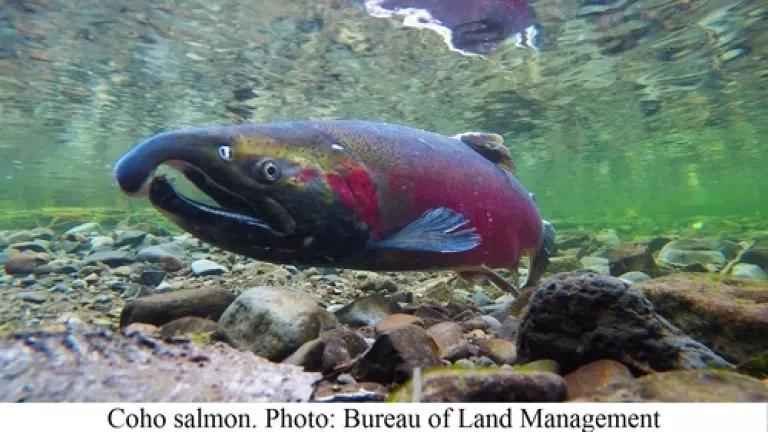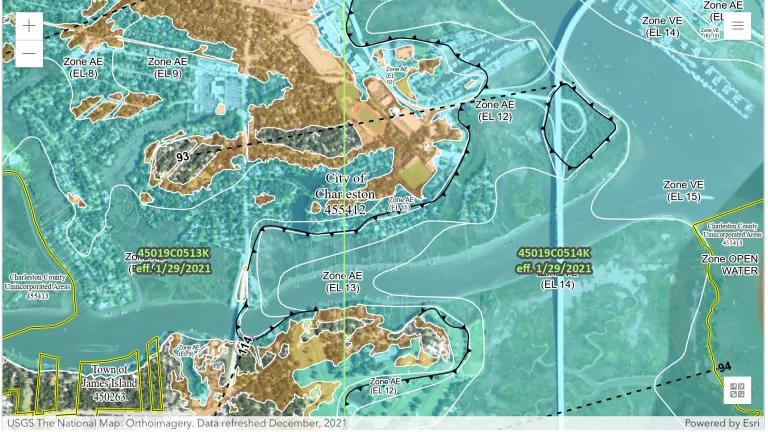The Cost of Federal Inaction: Local communities, taxpayers and endangered species suffer as agencies drag their heels on floodplain management

Willamette River, Oregon. 1996 Flood. Photo: National Weather Service
This week NRDC and eight other conservation and fishing organizations sent a letter to the National Marine Fisheries Service (NMFS) urging it to finalize an important and long-overdue assessment of how the National Flood Insurance Program harms Oregon's endangered salmon populations by enabling unsustainable floodplain development. NMFS's assessment, known as a biological opinion, is based on clear evidence that floodplain development is encouraged by the taxpayer subsidized flood insurance program. This development contributes habitat loss that jeopardizes the survival of the state's vitally important salmon runs while also exacerbating channel erosion and flooding. After four years of discussion between NMFS and the Federal Emergency Management Agency (FEMA), who administers the NFIP, it's high time that NMFS finalize this opinion.
Continued delay further jeopardizes endangered salmon populations as well as communities that reside on floodplains. What's more, delay by NMFS and other federal agencies runs contrary to the urgency of recent federal efforts to advance flood protection, resiliency and public safety.
FEMA, floodplains and fish
For decades, cheap federally subsidized flood insurance has fueled development in floodplains. While the NFIP was originally created in 1968 to improve public safety and reduce the risk and cost of flooding, it has ironically made easier for developers to build and sell properties that are vulnerable to flooding. Another consequence has been the impact of the NFIP on fish and wildlife, including Oregon's endangered salmon runs.

Floodplains provide important flood protection and economic benefits. They safely store flood waters, recharge groundwater aquifers for water supplies, improve water quality and provide habitat for fish and wildlife that support recreation, tourism and commercial fisheries industries. However, development in floodplains reduces these benefits and puts people, homes, businesses and infrastructure in harm's way during floods.
Changes are needed to the NFIP in Oregon
The NFIP identifies 251 communities in Oregon as flood-prone. Communities in Oregon have experienced damaging floods in 42 of the last 55 years. Since 1995, there have been 12 flood-related Presidential Disaster Declarations. Since 1978, there have been 5,232 flood damage claims costing taxpayers over $91 million. While Oregon's floodplains have been developed, the states salmon populations have declined to below 20% of their historical levels. Southern resident orca populations have declined in response to these diminishing salmon populations and are now listed as endangered. Loss of floodplain habitat has contributed to these declines. In the Willamette River Valley, development has decreased the river's channel area by more than 43%. On the Oregon Coast, Tillamook Bay has lost 90% of its tidal estuary wetlands and their capacity to buffer against flooding and provide habitat for salmon and steelhead.

The NFIP has driven up the number of lives and properties at risk while diminishing the economic and environmental benefits of floodplains. The NFIP is clearly broken and in need of repair.
Five reasons why NMFS should complete the biological opinion for the benefit of Oregon and the nation
1. The biological opinion will make Oregon communities safer. NMFS' biological opinion will include a "Reasonable and Prudent Alternative" or RPA describing a plan to implement the NFIP in a way that would avoid harming endangered species, and in this case, also improve public safety. A March 2015 draft of the RPA included the following elements:
-
- Notice to communities: Informing communities in Oregon participating in the NFIP about the need to ensure that future development protects natural floodplain functions.
- Mapping special flood hazard areas: Conducting more accurate floodplain mapping that includes floodways (areas next to rivers that receive floodwaters during a base flood) and identifies additional flood hazard areas, including high-erosion zones.
- Floodplain management criteria: Requiring NFIP communities to avoid new unmitigated development that results in increased flood height, flow velocity and adverse effects on natural floodplain functions that imperil fish habitat and existing development on floodplains.
- Data collection and reporting: Requiring communities to collect data about development in special flood hazard areas and provide an annual report on community floodplain development.
- Compliance and enforcement: Placing communities that do not comply with new NFIP criteria on probation or suspending them from the NFIP, and incentivizing wise floodplain management practices with NFIP premium discounts as part of the Community Rating System.
- Interim measures: Taking immediate steps to prevent unmitigated development in the 100-year floodplain and provide FEMA time to develop a comprehensive implementation plan for the other elements.
2. The biological opinion is long-overdue. Technically, the entire consultation process between federal agencies is supposed to take no more than 135 days - not four years. NMFS and FEMA began consulting with each other in 2011 and even had the benefit of being able to build upon a similar 2008 jeopardy opinion for the NFIP in Washington's Puget Sound. While the release of a draft jeopardy opinion in September 2013 seemed to indicate forward progress, over the last two years, NMFS and FEMA have been stuck trying to resolve differences largely related to implementing land use measures for NFIP participants. After all these years, resolution of remaining issues should take place as part of the development of FEMA's implementation plan for the biological opinion and should not be the basis for prolonging issuance of the opinion.
3. Delaying the opinion increases flood risk for NFIP communities and cost to taxpayers. NMFS's jeopardy opinion for the Puget Sound and the 2013 draft jeopardy opinion for the state of Oregon are based on well-known and established facts that the NFIP fuels harmful floodplain development, exposes families and businesses to flood risk and has cost the nation's taxpayers billions of dollars. Continued delay exacerbates flood risk for 251 flood-prone communities in Oregon. A final opinion will help communities seeking to develop in the floodplain to do so responsibly and without harming listed species or causing flood impacts to other NFIP communities. Furthermore, the NFIP is $24 billion dollars in debt and the impacts of the program are currently being reassessed as part of a nation-wide Programmatic Environmental Impact Statement (PEIS). The Oregon biological opinion is needed to help inform that process to ensure that the NFIP achieves its intended benefits to public safety and reduced risk while protecting endangered species.
4. Climate change will only make things worse. A report prepared for FEMA on the impacts of climate change on the NFIP found that by 2100, riverine flood depths and flood areas are predicted to more than double in some areas of the Pacific Northwest. Because the RPA also recommends taking into consideration future conditions related to continued watershed development and climate change, the opinion will help Oregon be prepared for a warmer and more hazardous future.
5. Further delay is inconsistent with the urgency of recent federal actions. Since 1977, agencies have been required by Executive Order 11988 to avoid the long- and short-term adverse impacts associated with the occupancy and modification of floodplains, and to avoid direct or indirect support of floodplain development wherever there is a practicable alternative. However, growing awareness about the escalating frequency, risk and cost of major flood events, as well as the potential impacts of climate change, has prompted pressing action on the part of federal agencies and the administration, including Executive Order 13690 updating guidelines for floodplain development for federal projects. FEMA itself this year has made significant efforts to improve public safety and protect against flooding through coastal resiliency programs as well as through requiring states to address the flood-related impacts of climate change in their State Hazard Mitigation Plans. Further delay in releasing the opinion is inconsistent with the urgency with which other federal efforts are taking action to improve public safety.
Ironically, September is National Preparedness Month, a federal campaign to help raise awareness about the risk of natural disasters like flooding and reduce the impacts on our nation. At a time when the nation's flood risk is rising in response to continued floodplain development and effects of climate change, the cost of indecision may be measured with lives, billions in damages and the health of our environment. It is essential that federal agencies act now and complete the biological opinion to increase public safety, reduce costly flood damages and improve our nation's resiliency in the face of this reality.



